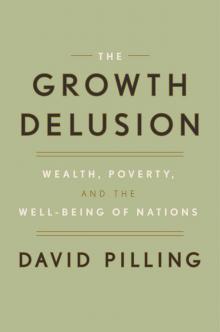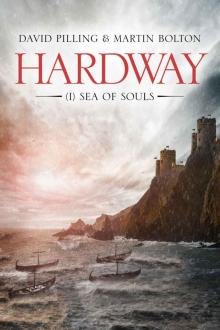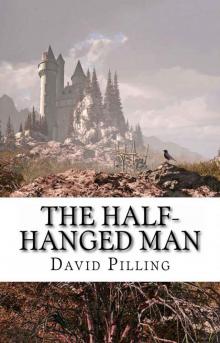- Home
- David Pilling
The Growth Delusion Page 16
The Growth Delusion Read online
Page 16
Valuing nature is no walk in the park. In fact it is more like a hack through the Congolese jungle. Still, a summary of Costanza’s findings goes as follows:
Figure 2
To call such methodology a back-of-the-envelope calculation would be to do a disservice to envelopes. (Or should I call them envelope services?) One response to such numbers is that they are gobbledygook. Why, for example, should nature’s cultural services, at $3 trillion, be worth almost twice its food production services, when presumably without the latter we wouldn’t be around to enjoy the former? But Costanza has been undaunted by the criticism that his exercise in intellectual bravado has stirred. Answering one critic, he wrote, “We do not believe that there is any one right way to value ecosystem services. But there is a wrong way, and that is not to do it at all.”5
* * *
—
In 2012 the British government formed the Natural Capital Committee, said to be the first of its kind in the world. The committee describes its work as “advising the government on natural capital, such as forests, rivers, minerals and oceans.” By 2020 the government wants the Office of National Statistics to incorporate a measure of natural capital into Britain’s national accounts. The committee will help develop “suitable metrics” to track the state of the environment and to benchmark the English countryside against the rest of the world. It will also draw up a “risk register” of endangered habitats and advise the government on its twenty-five-year environmental plan.
The seven-member committee is chaired by Dieter Helm, a professor at the University of Oxford and an expert in environmental accounting. Helm has formulated an iron law in his academic work that he hopes will steer the committee in the real world. The law sounds disarmingly simple, but it has complex implications. It goes like this: “The aggregate level of natural capital should not decline.”6
Helm starts with a standard definition of sustainable development: “Humanity has the ability to make development sustainable to ensure that it meets the needs of the present without compromising the ability of future generations to meet their own needs.”7 He goes on to describe what he calls a “chain letter between generations” in which the people of one generation sign an unwritten contract to leave the next generation with the resources to prosper. When it comes to natural capital, each generation is obliged to leave the stock of wealth as it found it. That’s what “The aggregate level of natural capital should not decline” means, he says.8
Clearly that does not imply that we cannot touch nature. No society, not even a pre-industrial one, could commit to that. Humans interact with their environment. They chop down trees and they plow fields. They siphon off non-renewable resources, such as oil and gas. They adapt, change or destroy renewable resources. They might transform part of a river by building a dam to produce hydroelectric power. Or they may, over generations, cut down primeval forest and replace it with the modern English countryside, with its hedgerows and pasture and cropland, or transform bison-rich prairies into wheat fields. It is unrealistic to expect one generation to leave the ecosystem exactly as it found it. The point is, says Helm, it should leave the aggregate amount of natural capital intact.
But how? And almost as important, how would we know? Peter Drucker, a management guru, is said to have reasoned, “If you can’t measure it, you can’t manage it.” That could have been a subtitle for this book. If nature is transformed from forest to sheep pen or from river to electricity, we need some kind of accounting tools to figure out how much of a net loss that is to the stock of natural capital and how much we need to do to compensate.
On one level the whole exercise is flawed. Economists are precisely not the type of people you want to start messing about with nature. As soon as they get their hands on our lakes and our forests, the danger is these will be commoditized and bought and sold into oblivion. In the end economists can’t answer questions like “Should we build on the greenbelt to relieve the housing shortage?” Some trade-offs are ethical and not susceptible to number-crunching. In theory an economist may decide that it is “worth” driving a river dolphin to extinction if the result is a hydroelectric plant producing so many megawatts of power for so many hundreds of thousands of people. Yet that is a question for a moralist as much as an economist. King Solomon is no less qualified to answer it than Mervyn King, governor of the Bank of England from 2003 to 2013. That doesn’t mean, however, that economists have nothing to contribute to the debate. It is at least worth hearing what they have to say.
In his quest to measure the unmeasurable, Helm first divides natural capital into two categories: renewable and non-renewable. There has traditionally been a lot of focus on non-renewable resources. Have we reached “peak oil”? How are we to manage when there’s no more coal or copper? But non-renewable resources are the easy part. They are relatively simple to value using market prices. If a government knows it has fifty years’ worth of natural gas, it can work out the value at today’s prices and decide how much it wants to “spend” today and how much to save for tomorrow.
Renewable resources are trickier. Take the example of wild salmon.9 We may know the value of salmon per pound, but since the fish reproduce indefinitely, it is impossible to quantify present and future revenue streams. They are infinite, which makes salmon effectively free. That is of course unless we drive them to extinction, in which case they become priceless—the word economists use for extinct. More important than valuing salmon, then, becomes working out where the threshold for their survival is. We need to know how much salmon we can safely take from a given location without endangering future supplies. Just as important, we also need to work out the thresholds for the ecosystem in which they flourish.10 We should err on the side of caution. Once we have identified a point beyond which we should not go, common sense dictates that we should stop well before reaching it.
One approach would be to draw up a natural capital balance sheet—especially of ecosystems that are at risk—in order to track aggregate levels of natural capital. Helm’s rule would require that damage to one bit of the ecosystem be offset by repair or improvement of another bit. If a wetland is destroyed to build a shopping mall, then the government (or private company) concerned would be obliged to offset that destruction by, say, improving the quality of soil or returning farmland to wilderness. If trees are chopped down, you must plant them elsewhere. Divert a river and you’re required to protect a wetland somewhere else. In the case of non-renewable resources like oil, you could simply compensate for its use either by building up other forms of capital, including savings for future generations, or by making repairs to renewable natural capital.
This may all sound abstruse. On one level it is. After all, humans can’t even agree on reducing carbon emissions, though science tells us pretty definitively that global warming could have—indeed already is having—brutal environmental consequences. Just ask any African farmer about the sudden unpredictability of rainfall patterns that had been constant for generations.11 The carbon-trading scheme meant to put a price on pollution has, by most accounts, been a miserable flop. People are extremely resistant to the idea of a carbon tax, usually on the grounds that it would harm growth. That makes it hard to believe we could do better in the task of measuring other assaults on nature—from destroying rain forests to creating rubbish landfills—and then actually doing something about it.
Difficult or not, Helm’s rule has become official British policy. If you squint closely enough at the governing Conservative Party’s 2015 and 2017 manifestos, you’ll find a variation of: “We pledge to be the first generation to leave the environment in a better state than we inherited it.” Of course it is easy for a political party to make such an open-ended commitment. Today’s political leaders will be long gone by the time their promise is tested. But that is precisely why, environmental economists argue, we need robust accounting methods to keep politicians honest.
&n
bsp; Although Helm talks as much about thresholds as he does about pricing nature, his committee did come up with valuations for trees and wetlands. In a report to the government, in which it determined that England’s natural capital was in “long-term decline,” the committee listed several priorities. Among its recommendations here are three, taken more or less at random.
• Woodland planting of up to 250,000 additional hectares. Located near towns and cities, such areas can generate net societal benefits in excess of £500 million per annum.
• Peatland restoration on around 140,000 hectares in upland areas. This would deliver net benefits of £570 million over 40 years in carbon values alone.
• Wetland creation on around 100,000 hectares, particularly in areas of suitable hydrology, upstream of major towns and cities, and avoiding areas of high grade agricultural land. Benefit: cost ratios of 3:1 would be typical, with 9:1 possible in some cases.
It is easy to scoff at such recommendations. That’s why people do. Written in the uninspiring language of official reports and with numbers that appear plucked from thin air, putting a price on nature seems crass at best. For a start, why should the units of measurement be monetary? We don’t measure weight or height in dollars or euros. Yet kilograms and meters provide meaningful signals that we can act upon. For example, doctors can recommend that a patient go on a diet if his weight:height ratio creeps over a certain level. We know a runway has to be so long for an Airbus A380 to land. For safety purposes, we don’t need to know it costs $700 million to build. (Would we build a shorter one if it cost half the price?) So why, as one author puts it, has money become “the moral lingua franca”?12 We need to get away from the idea, dominant since the invention of GDP, that the only measurements worth a candle have $ or £ in front of them.
Money is a strange unit to apply to nature. We can print money at will—as our central banks have demonstrated with gay abandon. The whole point of trying to value the environment is surely to highlight finite constraints. By putting a price on carbon, one plausible conclusion is that we are free to pollute indefinitely so long as it is paid for in endlessly printable, potentially worthless, currency.13 Instead of pounds, dollars or euros, we could perhaps measure carbon in momme, a unit of mass for measuring pearls in Japan in which 1 momme = 10 fun. Alternatively, one author suggested, we could use Cat, an old American measure of the minimum fatal drug dose per kilo of cat.14 Personally, I would love to see Cat replace GDP as our principal measure for economic activity just so I could write the headline LAST QUARTER THE ECONOMY GREW BY A WHISKER.
Pricing nature might not only be meaningless, it could also be reckless. It suggests nature is fungible and can be safely traded; moreover, that it is only valuable to the extent that it performs a service for human beings. “The paradox of environmental economics is that we feel compeled to price nature to make its loss visible on the balance sheet, but in doing so we legitimize its commodification and validate its critical overconsumption”15 is how one author puts it. At its worst, “biodiversity offsetting” might mean that one piece of nature, with its beauty and wonder and millennia of history, could be mechanically substituted by another. A “hunched and fissured coppiced oak,” in the words of another author, becomes replaceable by a “sapling planted beside a slip-road with a rabbit guard around it.”16 To frame the debate using monetary values is to cede the moral high ground to economists with their ruthlessly utilitarian world view.
* * *
—
It is precisely to get around such dilemmas that some economists have taken a different, non-monetary approach. One such is that developed by the Global Footprint Network (GFN), a California-based research organization that has gone so far as to invent a new holiday. Just in case you missed it, August 2, 2017, was Earth Overshoot Day. If you’re American, it was the holiday wedged between Independence Day and Thanksgiving. It may not have been celebrated in your neighborhood and Hallmark has not yet produced cheesy cards in its honor, so don’t worry if it passed you by. Earth Overshoot Day marks the date on which humans have used up all of the ecosystem’s regenerative capacity for that year. From that day onward in 2017 we were running down the earth’s ecological gas tank to fuel our consumption.
Earth Overshoot Day seeks to highlight the issue of sustainability by drawing attention to the ratio between our ecological footprint and the earth’s biocapacity—its capacity to absorb that activity and regenerate itself. It is an attempt to account for the environment in a currency other than dollars and cents. The GFN purports to provide a way of comparing what the earth is able to supply against the demands put upon it. Its founder and president, Mathis Wackernagel, insists that the methodology is scientifically rigorous, though many argue it is more useful as a tool of publicity than of policy.
Biocapacity is the earth’s capacity to provide humans and other animals with food and resources—wood for building houses, water for our crops, wildebeest for a lion’s breakfast—and to absorb the waste produced. That waste includes human pollution, such as nitrate runoff from farms and carbon emissions from industry. The demand is the footprint. GFN divides the earth into five broad categories: cropland, grazing land, forests, fisheries, and built-up land. Cropland provides food to eat, forests provide building materials, firewood and CO2 sequestration. Areas deemed mostly unproductive, such as deserts, are not counted.17 The basic unit of measurement is the global hectare. This is calculated by multiplying the physical area, say of cropland, by the yield, which varies from country to country, and by something called the equivalence factor, which accounts for the difference in productivity, say, between cropland and less productive grazing land. The methodology, though rough-and-ready, allows all land to be expressed in terms of a single unit—the global hectare.
GFN calculated that the total amount of productive land and water amounts to 12 billion global hectares. With roughly 7 billion people on earth, this equates to 1.72 global hectares per person.18 (A hectare is roughly the same size as a soccer pitch.) According to GFN, we have only relatively recently started exceeding the earth’s capacity to regenerate itself. In 1961 human demand accounted for 0.7 planet’s worth of biocapacity. That meant we were in the black. By the mid-1980s humanity had tipped into the red, and by 2008 the picture had changed dramatically. In that year, GFN said, we needed 1.5 planets to sustain us, something that is clearly unsustainable. It is enough to make Thomas Malthus stir from his grave to say, “I told you so.”
* * *
—
Wealth is a measure not only of the present but also of the future. That is because today’s wealth—the balance sheet of all our assets, natural, physical and institutional—is tomorrow’s income. That contrasts with our standard economic gauge—GDP—which is essentially a backward-looking measure, a way of recording what has already been produced, say in the past year. But trying to peer into the future raises important conceptual problems.
First, the value of today’s assets is essentially unknowable. That is largely because of changes in technology. Cobalt mined in Congo is today in high demand because it is an essential element for electric car batteries, but perhaps tomorrow some presently less valuable mineral will take its place. Depending on technological advances, we may be able to produce more with less in the future. Perhaps we’ll develop new techniques to extract previously unreachable oil and gas. That has already happened with the shale revolution. Perhaps we won’t need oil and gas at all; we’ll have new forms of energy, currently undiscovered or underutilized.
Some economists view attempts to measure natural capital as essentially bogus, a tool of environmentalists who want to impose unnecessary constraints on growth. Larry Summers, a US economist, goes so far as to suggest it is a way for people who are already rich to tell those who are poor that they’re dreadfully sorry, but the planet just can’t take any more growth.
“In my view, it’s all a political doom and g
loom operation,” he practically growled down the phone when I raised the subject of how to measure natural wealth.19 “In any theory where depleting your oil constitutes a loss of GDP, finding new oil should constitute an increment to GDP. But they [environmental economists] never take account of anything positive. They’re quick to call it a depletion of capital if you deplete your oil. But they’re never honest enough to acknowledge that, when fracking technology is discovered, that is an augmentation to your resources,” he said.
“When we discover video conferencing technology and fewer people travel and put carbon in the air, we should be giving ourselves credit for that. But for the people who do this, it’s all a one-eyed operation in favor of everybody staying home. Everybody staying home and knitting.” Pushing aside the image of clacking needles and shapeless stripy sweaters, I pressed on. Surely it wouldn’t be hard to come up with a rigorous theoretical framework that went beyond environmentalist propaganda? “If you did the conceptually appropriate corrections, you might well conclude that GDP was growing faster. You have to do it both ways. You have to recognize bad things and you have to recognize good things. If it was done right, it might be interesting,” he said. “But I think the correct posture toward the people who are doing it now is disparagement.”

 The Growth Delusion
The Growth Delusion The Hooded Men
The Hooded Men Longsword
Longsword Medraut
Medraut Hardway
Hardway Holy Warrior
Holy Warrior Caesar's Sword: The Complete Campaigns
Caesar's Sword: The Complete Campaigns The Wolf Cub
The Wolf Cub Reiver
Reiver The Heretic
The Heretic Siege of Rome
Siege of Rome Loyalty
Loyalty The Path of Sorrow
The Path of Sorrow Caesar's Sword (I): The Red Death
Caesar's Sword (I): The Red Death Flame of the West
Flame of the West The Best Weapon
The Best Weapon Sacrifice
Sacrifice The Half-Hanged Man
The Half-Hanged Man